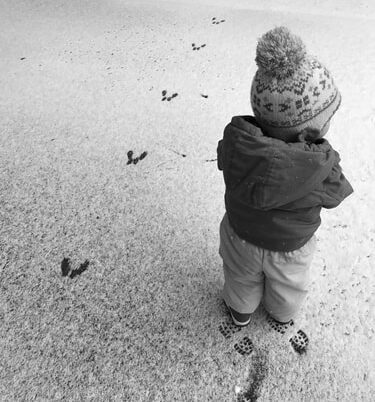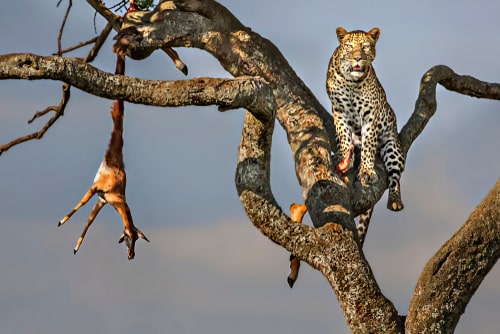
Before the rise of urban life, kids spent a lot of time learning read the visual clues left behind by other animals. Nowadays, many kids never get to learn the art of animal tracking. But maybe they should. Tracking gets kids outdoors and interested in wildlife. It may also provide kids with opportunities to practice scientific reasoning, spatial skills, and symbolic thought.
Animal tracking in anthropological perspective
If you live in the urban world, you might not do much tracking. But for some people, tracking animals–and reading the clues they leave behind–are a crucial part of daily life.
In the Western Desert of Australia, hunter-gatherer children as young as five years old track lizards and birds (Bird and Bird 2004).
Boys in the Kalahari must learn how to track prey for hours at a time, because large, fleet-footed prey animals usually escape the first attack. Typically, hunters shoot prey with poisoned arrows and then follow the weakened animals until they finally collapse (Liebenberg 2008).
This “persistence hunting” — which may have been widespread among early human foragers — requires subtle detective work. Wounded prey animals are frequently out of visual range. To avoid losing the trail, hunters must make careful observations of the environment and make inferences about past events.
Such detective work is useful in other contexts besides hunting.
In East Africa, local herdsman know how to recognize (and avoid) the tracks left behind by a python. They also understand the significance of a dead impala draped across the branches of a tree. Leopards stash their kills in trees to prevent them from being stolen by scavengers. So a dead ungulate in the branches means that a leopard is nearby.

Interestingly, the local monkeys fail to show an understanding of such visual signs. In field experiments, primatologists Dorothy Cheney and Richard Seyfarth hung a stuffed gazelle carcass from a tree and then observed how wild vervet monkeys behaved. The monkeys seemed oblivious to this sign of danger. Similarly, the monkeys ignored python tracks (Cheney and Seyfarth 1990).
Time well spent?
For most of human history, children’s daily lives probably resembled those of modern-day hunter-gatherers. Kids spent their days outdoors, paying close attention to the behavior of other animals. They participated in foraging. They learned to hunt small game, steal eggs, and find edible insects. They learned to track.
In fact, archaeologist Steven Mithen has proposed that Upper Paleolithic art functioned, in part, to teach children about tracks, hoof-prints, and other animal signs important for hunting (Mithen 1988). For example, many European cave paintings depict animals with their feet unnaturally twisted, so that the feet are drawn as you would see them in tracks (Guthrie 1984).
So it’s interesting to consider: What have we lost? Urbanized parents often worry that their kids spend too much time playing electronic games or watching television. We worry that our kids have overly short attention spans. We want our kids to go outside, to get more exercise. We want to encourage our kids to be active, to think critically, and discover an enthusiasm for science.
It seems to me that animal tracking addresses all of these concerns. Tracking takes kids outside. It gives them reason to move their bodies and pay close attention to their environment.
And tracking is an intellectual exercise, too.
Maybe that isn’t obvious. After all, dogs are good trackers, and they aren’t as smart as our children. But dogs rely on chemical clues—like smell—to track. To follow a scent trail, an animal may need little more than the ability to detect differences in the intensity of an odor. The stronger the odor, the closer the target. If the scent trail is broken, the dog may lose chase.
Humans rely on visual clues, and these clues may require complex inferences to decode. Perhaps that’s why the vervet monkeys performed so poorly on the leopard kill test. They didn’t have the right kind of smarts.
Just consider all the sophisticated cognitive funtions that a tracker performs:
- Scientific thinking. As researchers like Louis Lieberberg and Peter Carruthers have argued, successful trackers must reason like scientists (Liebenberg 1990; Carruthers 2002). Trackers attempt to explain the clues they find. They develop hypotheses about what animals were doing when they left these clues. They make predictions about what the animals were likely to do next. They debate their ideas with other trackers and put their predictions to the test.
- Cognitive reflection. All of us are prone to make snap judgements, to act on easy, quick intuitions. But this type of response can lead to major cognitive errors, and studies confirm for both children and adults: We’re more likely to reach accurate conclusions when we take a moment to stop, reflect, and question our immediate intuitions (Young and Shtulman 2020). Tracking is an opportunity for children to learn about the value of cognitive reflection. When we discover a possible clue, we can stop and ask questions. Who might have left this clue behind? Why do you think this? Can you think of any alternative possibilities? Which seems the most likely, and why?
- Spatial thinking. When you walk, only some parts of your foot make contact with the ground—the tips of the toes, the ball of the foot, the heel. So a footprint doesn’t look exactly like the foot that makes it. Experimenting with prints and tracks is an opportunity for kids to think about three-dimensional objects: What parts of an animal’s foot will leave a mark on the ground? And how might the properties of the ground’s surface—be it sandy or snowy or muddy—influence the shape of a foot print?
- Symbolic thought. Tracking may also involve a form of symbolic thinking. To reason about animal tracks, I have to understand that a sign (squiggly marks in the dust) stands for something entirely different (a living snake). So maybe “reading” tracks is not unlike reading pictograms or hieroglyphics. And perhaps teaching preliterate children about animal tracks helps them develop an understanding of symbols, preparing them for other symbol reading activities, like learning the alphabet.
Does this mean that animal tracking will make our kids smarter? Maybe not. But it would be interesting to test the effects of tracking experiences on young children’s analytical, spatial, and symbolic thinking skills. In the future, maybe somebody will run the experiment. Meanwhile, it seems a good bet that tracking is about intellectual, rather than physical, prowess.
In a study of the Ache, a hunter-gatherer culture in Eastern Paraguay, researchers found that men didn’t become expert hunters until their late 30s — long after they had developed their peak body strength. The researchers concluded that hunting success depends on “stealth and know how” rather than sheer strength (Walker et al 2002).
More to explore
For more information about the importance of cognitive reflection, see my article, “Teaching critical thinking: The first step is to pause and reflect.”
For additional activities that foster spatial reasoning skills, see my article, “Improving spatial skills in children and teens: 12 evidence-based tips.”
And for tips on getting young children interested in animal tracking, check out these preschool and kindergarten activities.
References: The anthropology of animal tracking
Bird DW and Bird RB. 2005. Martu children’s hunting strategies in the Western Desert, Australia. In BS Hewlett and ME Lamb (eds.), Hunter-gatherer childhoods: Evolutionary, developmental and cultural perpectives. New Brunswick: Transaction Publishers.
Carruthers P. 2002. The roots of scientific reasoning: infancy, modularity, and the art of tracking. In P. Carruthers, S. Stich and M.Siegal (eds.), The Cognitive Basis of Science. Cambridge: Cambridge University Press.
Cheney D and Seyfarth R. 1990. How monkeys see the world: Inside the mind of another species. Chicago: University of Chicago.
Guthrie D. 1984. Ethological observations from Paleolithic art. In HG Bandi, H Huber, MR Sauter and B Sitter (eds): La contribution de la zoologie et de l’ethnologie a l’interpretation de l’art des peoples chasseaurs prehistoriques. Fribourg, Suiss: Editions Universitaires Fribourg.
Leibenberg L. 2008. The relevance of persistence hunting to human evolution. Journal of Human Evolution 55: 1156-1159.
Leibenberg L. 1990. The art of tracking: The origin of science. Cape Town: David Philip publishers.
Mithen S. 1988. Looking and learning: Upper Paleolithic art and information gathering. World Archaeology 19(3): 296-327.
Walker RS, Hill K, Kaplan H and MacMillan G. 2002. Age-dependency in hunting ability among the Ache of eastern Paraguay. Journal of Human Evolution 42:639-657.
Young AG and Shtulman A. 2020. How Children’s Cognitive Reflection Shapes Their Science Understanding. Front Psychol. 11:1247.
Content last modified 2/22
image of toddler in the snow with animal tracks by Wendy D’Agata-Potamis / shutterstock
image of leopard with dead prey by MehmetO / shutterstock